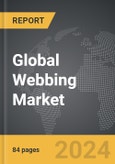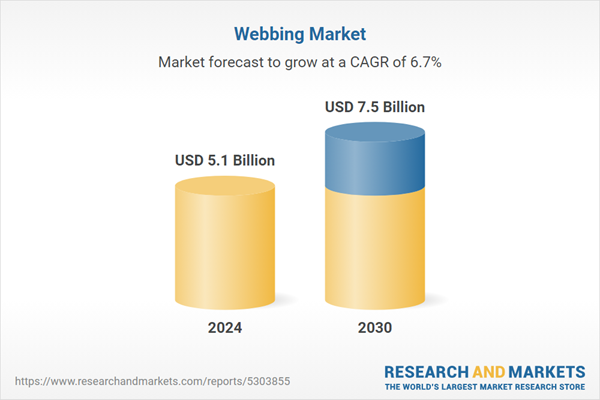The global market for Webbing was valued at US$5.1 Billion in 2024 and is projected to reach US$7.5 Billion by 2030, growing at a CAGR of 6.7% from 2024 to 2030. This comprehensive report provides an in-depth analysis of market trends, drivers, and forecasts, helping you make informed business decisions. The report includes the most recent global tariff developments and how they impact the Webbing market.
The webbing market is experiencing significant growth driven by several key factors. One of the primary drivers is the increasing demand in the automotive industry for safety components such as seat belts and airbags, which require high-quality webbing to ensure passenger safety. As the automotive industry continues to grow, particularly with the rise in vehicle production in emerging economies, the need for durable and reliable webbing materials escalates. Additionally, the outdoor and adventure sports industry is booming, with more people participating in activities such as climbing, hiking, and camping. This surge in outdoor activities has led to a higher demand for webbing in products like harnesses, backpacks, and tents, which rely on the strength and durability of webbing to withstand extreme conditions. Another significant growth driver is the military and defense sector, where webbing is used extensively in gear and equipment such as tactical vests, parachutes, and cargo nets. The continuous modernization and upgrading of military equipment worldwide are boosting the demand for advanced webbing materials that offer enhanced performance and reliability.
Several trends are shaping the webbing market, reflecting the evolving needs and preferences of various industries. One notable trend is the development of eco-friendly and sustainable webbing materials. With increasing environmental concerns and consumer demand for sustainable products, manufacturers are exploring alternatives such as recycled polyester and biodegradable webbing. These eco-friendly options not only reduce the environmental impact but also appeal to environmentally conscious consumers and companies. Another trend is the integration of smart technologies into webbing products. Innovations such as webbing with embedded sensors for monitoring load and strain are gaining traction in industries like construction and aerospace. These smart webbing solutions provide real-time data and enhance safety by alerting users to potential failures or overloading conditions. Additionally, customization and personalization of webbing products are becoming increasingly popular. Customers are seeking webbing solutions tailored to their specific needs, whether it’s for unique color patterns, strength requirements, or branding purposes. Manufacturers are responding to this trend by offering more customizable options and expanding their product lines to cater to diverse applications.
Segments: Product (Polyester, p-Aramid Fibers, Carbon Fibers, Nylon, Polypropylene, UHMWPE, Other Products); Application (Automotive, Industrial, Sporting Goods, Military, Other Applications).
Geographic Regions/Countries: World; United States; Canada; Japan; China; Europe (France; Germany; Italy; United Kingdom; Spain; Russia; and Rest of Europe); Asia-Pacific (Australia; India; South Korea; and Rest of Asia-Pacific); Latin America (Argentina; Brazil; Mexico; and Rest of Latin America); Middle East (Iran; Israel; Saudi Arabia; United Arab Emirates; and Rest of Middle East); and Africa.
The analysts continuously track trade developments worldwide, drawing insights from leading global economists and over 200 industry and policy institutions, including think tanks, trade organizations, and national economic advisory bodies. This intelligence is integrated into forecasting models to provide timely, data-driven analysis of emerging risks and opportunities.
Global Webbing Market - Key Drivers and Trends Summarized
Webbing is a strong, woven fabric strip or tube often used in place of rope or traditional straps in various applications. It is typically made from synthetic fibers such as nylon, polyester, or polypropylene, but can also be crafted from natural fibers like cotton. Webbing is known for its durability, flexibility, and strength, making it an essential component in a wide range of industries, including military, automotive, sporting goods, and outdoor equipment. It is used in products such as seat belts, harnesses, slings, backpacks, and climbing gear, where safety and reliability are paramount.The webbing market is experiencing significant growth driven by several key factors. One of the primary drivers is the increasing demand in the automotive industry for safety components such as seat belts and airbags, which require high-quality webbing to ensure passenger safety. As the automotive industry continues to grow, particularly with the rise in vehicle production in emerging economies, the need for durable and reliable webbing materials escalates. Additionally, the outdoor and adventure sports industry is booming, with more people participating in activities such as climbing, hiking, and camping. This surge in outdoor activities has led to a higher demand for webbing in products like harnesses, backpacks, and tents, which rely on the strength and durability of webbing to withstand extreme conditions. Another significant growth driver is the military and defense sector, where webbing is used extensively in gear and equipment such as tactical vests, parachutes, and cargo nets. The continuous modernization and upgrading of military equipment worldwide are boosting the demand for advanced webbing materials that offer enhanced performance and reliability.
Several trends are shaping the webbing market, reflecting the evolving needs and preferences of various industries. One notable trend is the development of eco-friendly and sustainable webbing materials. With increasing environmental concerns and consumer demand for sustainable products, manufacturers are exploring alternatives such as recycled polyester and biodegradable webbing. These eco-friendly options not only reduce the environmental impact but also appeal to environmentally conscious consumers and companies. Another trend is the integration of smart technologies into webbing products. Innovations such as webbing with embedded sensors for monitoring load and strain are gaining traction in industries like construction and aerospace. These smart webbing solutions provide real-time data and enhance safety by alerting users to potential failures or overloading conditions. Additionally, customization and personalization of webbing products are becoming increasingly popular. Customers are seeking webbing solutions tailored to their specific needs, whether it’s for unique color patterns, strength requirements, or branding purposes. Manufacturers are responding to this trend by offering more customizable options and expanding their product lines to cater to diverse applications.
Report Scope
The report analyzes the Webbing market, presented in terms of units. The analysis covers the key segments and geographic regions outlined below.Segments: Product (Polyester, p-Aramid Fibers, Carbon Fibers, Nylon, Polypropylene, UHMWPE, Other Products); Application (Automotive, Industrial, Sporting Goods, Military, Other Applications).
Geographic Regions/Countries: World; United States; Canada; Japan; China; Europe (France; Germany; Italy; United Kingdom; Spain; Russia; and Rest of Europe); Asia-Pacific (Australia; India; South Korea; and Rest of Asia-Pacific); Latin America (Argentina; Brazil; Mexico; and Rest of Latin America); Middle East (Iran; Israel; Saudi Arabia; United Arab Emirates; and Rest of Middle East); and Africa.
Key Insights:
- Market Growth: Understand the significant growth trajectory of the Polyester segment, which is expected to reach US$1.8 Billion by 2030 with a CAGR of a 7.0%. The p-Aramid Fibers segment is also set to grow at 7.3% CAGR over the analysis period.
- Regional Analysis: Gain insights into the U.S. market, valued at $1.3 Billion in 2024, and China, forecasted to grow at an impressive 9.8% CAGR to reach $1.7 Billion by 2030. Discover growth trends in other key regions, including Japan, Canada, Germany, and the Asia-Pacific.
Why You Should Buy This Report:
- Detailed Market Analysis: Access a thorough analysis of the Global Webbing Market, covering all major geographic regions and market segments.
- Competitive Insights: Get an overview of the competitive landscape, including the market presence of major players across different geographies.
- Future Trends and Drivers: Understand the key trends and drivers shaping the future of the Global Webbing Market.
- Actionable Insights: Benefit from actionable insights that can help you identify new revenue opportunities and make strategic business decisions.
Key Questions Answered:
- How is the Global Webbing Market expected to evolve by 2030?
- What are the main drivers and restraints affecting the market?
- Which market segments will grow the most over the forecast period?
- How will market shares for different regions and segments change by 2030?
- Who are the leading players in the market, and what are their prospects?
Report Features:
- Comprehensive Market Data: Independent analysis of annual sales and market forecasts in US$ Million from 2024 to 2030.
- In-Depth Regional Analysis: Detailed insights into key markets, including the U.S., China, Japan, Canada, Europe, Asia-Pacific, Latin America, Middle East, and Africa.
- Company Profiles: Coverage of players such as American Cord & Webbing Co., Inc. (ACW Co., Inc.), Bally Ribbon Mills, Belt-tech, E. Oppermann GmbH, Jiangsu Daxin Webbing Co., Ltd. and more.
- Complimentary Updates: Receive free report updates for one year to keep you informed of the latest market developments.
Some of the 24 companies featured in this Webbing market report include:
- American Cord & Webbing Co., Inc. (ACW Co., Inc.)
- Bally Ribbon Mills
- Belt-tech
- E. Oppermann GmbH
- Jiangsu Daxin Webbing Co., Ltd.
- Murdock Webbing Company, Inc.
- Narrowtex Australia Pty Ltd.
- National Webbing Products
- Ohio Plastics Belting Co.
- Tennessee Webbing Products
Tariff Impact Analysis: Key Insights for 2025
Global tariff negotiations across 180+ countries are reshaping supply chains, costs, and competitiveness. This report reflects the latest developments as of April 2025 and incorporates forward-looking insights into the market outlook.The analysts continuously track trade developments worldwide, drawing insights from leading global economists and over 200 industry and policy institutions, including think tanks, trade organizations, and national economic advisory bodies. This intelligence is integrated into forecasting models to provide timely, data-driven analysis of emerging risks and opportunities.
What’s Included in This Edition:
- Tariff-adjusted market forecasts by region and segment
- Analysis of cost and supply chain implications by sourcing and trade exposure
- Strategic insights into geographic shifts
Buyers receive a free July 2025 update with:
- Finalized tariff impacts and new trade agreement effects
- Updated projections reflecting global sourcing and cost shifts
- Expanded country-specific coverage across the industry
Table of Contents
I. METHODOLOGYII. EXECUTIVE SUMMARY2. FOCUS ON SELECT PLAYERSIII. MARKET ANALYSISCANADAITALYSPAINRUSSIAREST OF EUROPESOUTH KOREAREST OF ASIA-PACIFICARGENTINABRAZILMEXICOREST OF LATIN AMERICAIRANISRAELSAUDI ARABIAUNITED ARAB EMIRATESREST OF MIDDLE EASTIV. COMPETITION
1. MARKET OVERVIEW
3. MARKET TRENDS & DRIVERS
4. GLOBAL MARKET PERSPECTIVE
UNITED STATES
JAPAN
CHINA
EUROPE
FRANCE
GERMANY
UNITED KINGDOM
ASIA-PACIFIC
AUSTRALIA
INDIA
LATIN AMERICA
MIDDLE EAST
AFRICA
Companies Mentioned (Partial List)
A selection of companies mentioned in this report includes, but is not limited to:
- American Cord & Webbing Co., Inc. (ACW Co., Inc.)
- Bally Ribbon Mills
- Belt-tech
- E. Oppermann GmbH
- Jiangsu Daxin Webbing Co., Ltd.
- Murdock Webbing Company, Inc.
- Narrowtex Australia Pty Ltd.
- National Webbing Products
- Ohio Plastics Belting Co.
- Tennessee Webbing Products
Table Information
| Report Attribute | Details |
|---|---|
| No. of Pages | 84 |
| Published | April 2025 |
| Forecast Period | 2024 - 2030 |
| Estimated Market Value ( USD | $ 5.1 Billion |
| Forecasted Market Value ( USD | $ 7.5 Billion |
| Compound Annual Growth Rate | 6.7% |
| Regions Covered | Global |









